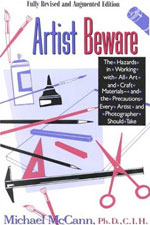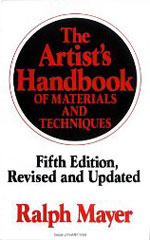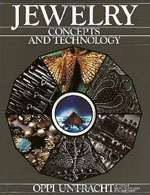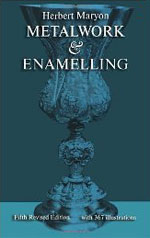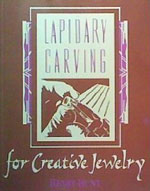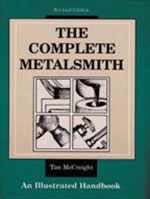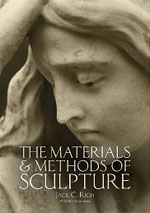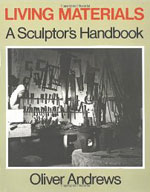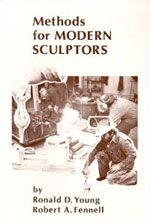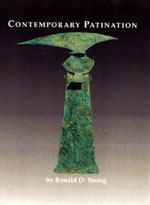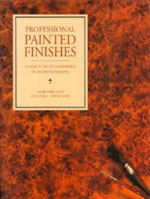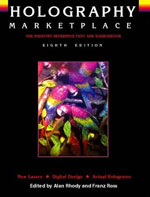We’ve frequently received e-mail from visitors to our site who have requested recommendations for books on the various art techniques and materials I use and discuss. Now it is possible to buy these online, through our association with Amazon.com.
-
Artist Beware
Every artist should definitely have this book. Dr. Michael McCann has made safety for artists a personal crusade, and his book will doubtless help some of us avoid sickness and even premature death. The book is divided into two sections, the first covering such issues as which materials are toxic, general studio safety, adequate ventilation, personal protective equipment, and what to do in case of illness. The second section analyzes the hazards of the major art-making processes, discussing the safety problems one is likely to encounter in doing painting, printmaking, ceramics, sculpture, metalwork, photography, and other crafts. Individual materials are talked about in context of their use, so pigments, for instance, are listed in the painting section, but any material in the book can also be found through the index. Each potentially toxic material is given a relative toxicity rating for skin contact, inhalation, and ingestion, the specific hazards associated with the material are mentioned, and specific precautions are advised. There are a few drawings and black and white photos of protective equipment, and some charts, tables and diagrams as well, illustrating such things as the type of glove to wear with which solvents, and the pain thresholds associated with various noises. Buy this book, if you mess around with art materials at all; remember, what you don’t know can hurt you.
-
The Artist’s Handbook
This should really be called the Painter’s Handbook, since there is only a token mention of sculpture processes, and even print-making techniques are dealt with briefly; but—that said—it contains the best analysis of the components from which various paints are made, how they work, what their limitations are, and how to use them effectively, that I’ve come across in any book. Oil painting gets the fullest discussion, but more obscure practices like fresco, encaustic, and silicon-ester painting are dealt with too. This book’s strongest feature is its in-depth discussion of various materials. If one wishes to learn the difference between gum arabic, for instance, and gum tragacanth; or how exactly to break an egg for tempera painting; this is the place to look. There is a sizable section on conservation, which goes into detail on the arcane processes of relining, cleaning, and even patching old pictures. Although this has been the painter’s Bible for many years, it has been kept up-to-date through periodic revisions and extensions, so one can find out about newer materials such as acrylic emulsion as well as older ones like casein. There are very few illustrations of any kind, however, beside a handful of drawings and diagrams.
-
Jewelry Concepts and Technology
If I was only going to get one book about making jewelry to last me all my life, this would have to be the one. Oppi Untracht, author of the authoritative Metal Techniques for Craftsmen, now out of print, which described nearly every technique practiced anywhere in the world that it was possible to do with metal, has now done the same for jewelry. This monumental book, covers the jewelry metals from mining to polishing and nearly every other material that is—or has ever been—used for jewelry. Traditional techniques, like sheet-metal forming, soldering, and casting, carving and etching are explored in depth. And new methods being tried experimentally by jewelry artists are given full treatment as well. There are numerous photographically illustrated step-by-step demonstrations of complex processes by guest artists, such as one which follows Stanley Lechtzin through the production of an amazing cast acrylic pendant with embedded photo images and electroformed and plated metal components. The book is copiously illustrated with color and grayscale photos and drawings of tools, equipment and many examples of historical and contemporary jewelry which utilize the techniques being explained in the adjacent section of the book. My only problem with this book is that when I try to read it, I usually get so excited about some thing it makes me want to try that I run off to the workshop and never finish my reading.
-
Metalwork and Enamelling
Written by the master jeweler who was responsible for restoring the Sutton Hoo ship treasure for the British Museum, this book is something of a museum-piece itself. Although it was revised in 1971 by the author’s son, incorporating some newer developments in the field, it is primarily a source of information on how things were done in the old days, around the beginning of the century (the first edition was published in 1912.) But since older techniques are often revived, and a lot hasn’t changed appreciably in this profession, much of the material presented will be of interest to the modern practitioner. Maryon himself drew from the work of the ancient craftsmen whose work he emulated, as well as on the work of Japanese and other traditional jewelry practices. In this book, he deals with many techniques in depth that just rate a mention in more modern works, like the operation of the mouth-blowpipe for fine soldering, the preparation and use of niello, and the technique of repousse’. For someone interested in historical metalwork, or a person without access to sources of modern tools and materials, this will be a very valuable book indeed. It is illustrated with drawings portraying the tools and processes he talks about, as well as with some grayscale photos showing historical examples of fine metalwork and 72 different twisted wire patterns.
-
Lapidary Carving for Creative Jewelry
In this book, a master lapidary shares his secrets, and his obsession with the light that flows through transparent gemstones. Instead of restricting himself to the traditional shapes generally used, he has made a career out of exploring the sculptural and optical possibilities of these small but refractive jewels. He patiently explains the processes used in cutting, carving, and polishing his obdurate materials into gems in which ambient light is captured, concentrated, and released in a pleasing manner which complements their forms. The different sorts of transparent colored gemstones available; like tourmaline, peridot, beryl, corundum and the quartz species; are covered individually in depth, with due examination of the particular problems they present. There is a section on making tools, which shows, among other things, how one can make ones own miniature abrasive grinding wheels from grit and clay, and how to turn polishing points from wood. The book is illustrated with black and white photos of the author’s work, (which are adequate to show the forms although one misses the colors), and also includes some pictures of the tools and equipment used. This book did inspire me to get started in gemstone carving; the hard part was to outgrow the powerful influence of his artistic style.
-
The Complete Metalsmith
The title is something of a misnomer; this book is about metalsmithing as it relates to jewelrymaking. As such, it is an excellent contribution; its visually oriented layout and profuse hand-drawn illustrations make it easy to follow when then author goes step by step through a process like making a rivet or weaving a chain. He is especially good at providing alternatives to the expensive and flimsy findings jewelers commonly use, illustrating various hinges, catches, chains, and clasps. He covers several schemes for setting stones, such as bezel, prong, and gypsy settings, and has a chapter devoted to casting. He gives a one-page summary of the working properties of each of ten metals or metal groups, including iron and steel, aluminum, white metals, titantium and niobium as well as the more usual jewelry metals. There is a section on tools, which can often be improvised from inexpensive or scrap items, and he gives plans for the construction of two styles of jeweler’s bench. There are also some useful tables included, like Centigrade to Farenheit conversions; gauge, mm, inch, and drill sizes compared; and weight per square foot charts for precious metals. This is a good book for anyone who wants a graphic overview of the processes involved in making metal jewelry by hand, while still providing some items of interest to an experienced worker in the field.
-
The Complete Modern Blacksmith
A compilation into one volume of three books that had gone out of print: The Modern Blacksmith, the Making of Tools, and one about reusing found metal objects. These shared an admirably practical approach to adapting this old craft to the modern age, explaining how to adapt junkyard finds like old automobile springs, worn-out files, and discarded railroad rails into useful items like cold chisels, carving gouges, and anvils as well as decorative hinges, fireplace tongs, wallhooks, and doorlatches. A sculptor himself, the late Mr. Weygers managed to completely outfit himself for wood-carving, stone-carving, and metal-working by repurposing the material that came to hand, and he shows the rest of us how to become free of the constraints posed by relying on pre-made tools, and be able to make ourselves exactly the tool we may need. He explains the hardening and tempering process in full, and gives methods to tell the difference between various ferrous metals. Basic techniques like bending, tapering, and upsetting are covered in detail, as is the equipping and setup of the smithy. These were the best books about steel I’ve ever read—I’m glad they can once again be found.
-
Techniques of Kiln-Formed Glass
Even if you weren’t interested in actually doing glasswork yourself, this book would be worth buying for the gorgeous photographs in color and black and white showing examples of what can be done with glass and a kiln. There is a section which traces the history of this process from its roots in ancient Egypt and Mesopotamia, through classical Greece and Rome, then through its subsequent eclipse and rediscovery in the 19th century by such artists as Henri Cros and Frederick Carder. But as well as being a coffee-table art book, this serves as a thorough guide to the technical aspects of casting, slumping, and sintering glass for someone who might want to start manipulating glass for use in their sculpture, jewelry, or other crafts. It contains a solid core of information, covering forming techniques like the slumping of sheet-glass over a form, the lamination of glass on glass, stretching and fusing, dribble-casting, and lost wax casting with pate de verre. The book features process shots and diagrams to illustrate different techniques and the equipment necessary to carry them out. Anybody starting out in this field will find the tables of annealing temperature over time and thickness, and the recipes for mold materials particularly helpful. Although I haven’t attempted this yet myself, the examples shown of contemporary and historical work made me want to give it a try, and the detailed technical advice there gave me confidence I could succeed if I did.
-
The Materials and Methods of Sculpture
This is a classic text reprinted by Dover Press from the 1947 edition. While dated in some respects—for instance, there is no mention of synthetic materials such as silicone rubbers and urethane plastics, which were developed since then—it is a valuable resource for the many tips and tricks, recipes and charts it contains. Coming as he did from an era in which sculptors were more accustomed to mixing their own materials from scratch, he has many suggestions that will be novel to most sculptors working today, such as making molds with gelatin glue and mixing potato starch into plaster to make it soluble. He covers the traditional range of sculpture practices, from bronze-casting to stone and wood carving, fairly thoroughly, concentrating on dealing with the materials in a practical manner without preaching his aesthetic principles. He usually has something to say about using even obscure materials like butter, sulphur, and soap. The black and white illustrations give an idea of the sort of sculpture popular in the ‘thirties and early ‘forties, and there are also some drawings showing tools and equipment.
-
Living Materials—A Sculptor’s Handbook
This is an ambitious attempt at a general book on sculpture techniques. Aesthetics is discussed in the first chapter, then mercifully laid to rest for the remainder of the book in favor of technical issues. It manages to cover most methods traditionally used for making fine art sculpture, with chapters on clay, plaster, stone, wood, plastic, and metals. Bronze casting gets in-depth treatment, with sand, shell, and lost-wax investment casting discussed rather fully and illustrated with black-and white photos. Mold-making, however, is given short shrift, with only a few pages devoted to the subject. Each major chapter has a brief safety section, giving some hints on what one needs to protect oneself while dealing with the material at hand, and there are bibliographies and suppliers listed.
The book suffers from the fact it was put together posthumously after the tragic death of its author in a 1978 skin-diving accident off the coast of Southern California, where he was a Professor of Art. The technical information is a bit dated, especially for the plastics, (and there is no discussion of electronics) while the examples of sculpture given go from paleolithic times up to the early seventies, but not beyond. All in all, though, this book does present a lot of valuable information clearly, and deserves a place in the library of every sculptor, or would-be sculptor.
-
Methods for Modern Sculptors
This is a primer on the ceramic shell method of lost-wax bronze casting for artists. It includes information on wax-working, spruing and gating, and a little on mold-making, finishing and patination, but mainly concentrates on the mechanics of preparing the waxes, coating and drying, burning out and pouring ceramic shell molds. Mr Young’s hands-on knowledge and enthusiasm on this subject show in the writing and the diagrams that illustrate this useful book. While it isn’t the general treatment of sculpture techniques the title seems to promise, it is highly recommended to anyone contemplating producing bronze castings on their own.
-
Contemporary Patination
In this book, the author of Methods for Modern Sculptors (reviewed above) explains in depth the technique of achieving a permanent colored finish on non-ferrous metals, particularly the copper-based alloys, by chemical treatment. He defines the various ways a patina can be induced to form, and gives examples of fume patinas, buried patinas, and sprayed-on patinas, among others. The subject of safety is given due consideration, which is a good reason why one should buy this book instead of just getting a recipe and some chemicals and commencing—some of the materials and techniques used in this field are extremely dangerous, and should only be done by those properly equipped to deal with them. Just knowing what the hazards are will help one decide if a particular effect is worth attempting on ones own, and the guidance given will allow one to proceed more safely. The book is illustrated with drawings for the most part, but the most valuable illustrations are the color plates which show the effect of various patina recipes on different standard copper alloys; they do vary quite a bit, depending on the composition of the metal to which they are applied.
-
Professional Painted Finishes
This book is dedicated to the recently revived art of “faux” or fake finishes; paint used to simulate wood, marble, granite, and other stones, including novelty effects that may not resemble anything specific. It very thoroughly goes through the tools, materials, and techniques involved, and then gives examples of exactly how to go about simulating specific kinds of marble: Verde Issorie or Botticino, to name just a couple. It then goes on to the various species of wood, showing how to render their characteristic grain patterns. Techniques like Flogging, Spattering and Whisking, and Steel-wool Dragging are explained fully. The best thing about this book is the profuse use of color plates, which not only demonstrate step-by-step how the various effects are achieved, but make it seem like the results will really be beautiful as well as convincing. Unusually for a book of this sort, the authors include a section on the business of being a decorative painter, giving detailed advice on such matters as estimating, billing, and sample-making which seems to come from hard-won experience.
-
Holography Marketplace: 8th edition
This is an unbeatable overview of the state of the holographic art. There are chapters covering basic information such as what holograms are and how they are made, and guest articles from innovators in the field, who detail their progress in such areas as adding color to holograms, applying holography to fabric, developing new holographic films and photo-reactive crystals, and producing various types of holograms by the dot matrix or photo-resist mathods, among others. Technical details are explained clearly, in language a non-physicist can understand. It contains an international directory of players in the holographic field, including artists, producers, distributors, collectors, museums, equipment and supply manufacturers, and researchers. As well as written information, it features many examples of embossed holograms, including on the cover a full-color image done by a new process developed by Dai-Nippon printing of Japan—arguably worth the entire cost of the book itself.
Let me know if you’ve got a favorite art-instructional book you think should be included here. andrew@juxtamorph.com

